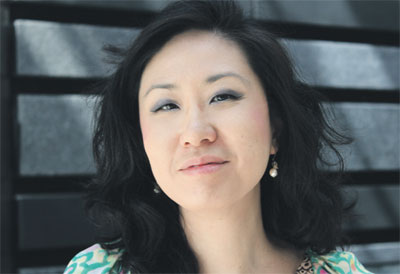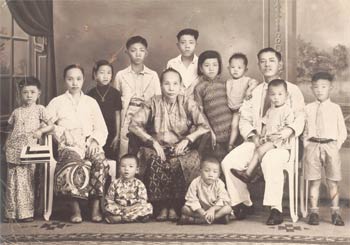
More than one way to see

Museum curator Szan Tan says history is not just found in books - different media can give you different views.
From ancient Greek artefacts to the theatre costumes of fashion designer Christian Lacroix, all sorts of things are important clues in the eyes of Szan Tan of the National Museum of Singapore. Ms Tan is a senior curator. It is her job to piece together whatever she can find to tell stories about the past.
For the museum's exhibition of family portraits, "Being Together", she selected around 40 photographs to show a slice of Singapore's history. She explained to What's Up how such everyday materials can add to our understanding of the past.
Q: How did you curate the historical portraits segment for "Being Together"?
A: First, I searched through the collections database at our Heritage Conservation Centre, where Singapore's National Cultural treasures are housed. After going through nearly 3,000 images, I selected about 50 that were relevant to the theme. I also checked that they were physically suitable for display. Finally, I worked with the exhibition designer, conservator and mounter on how best to display the final 40 images.
Q: If we want to uncover Singapore's history, why can't we just go read a history book?
A: Written accounts only provide one aspect of history. As curators, material culture is very important to us in providing a more holistic narrative. We piece together various aspects of history through objects, images, written accounts, as well as from recordings found in the oral archives. For example, oral history recordings can provide first-hand encounters of historical events, while old video footage can give us a glimpse of what the conditions were like in the past.

A: Visual clues in portraits in particular are very telling. They inform us of the social status, taste, fashion and, to some extent, psychology of the people in the photograph. Through examining personal documents like family portraits, we can discover more. For instance, in this portrait of a Straits Chinese Family, the many children in it reflects the social standing of such Peranakan families and their ability to cater for so many. Some of the males are wearing suits, which suggests that they were Western-educated.
Q: Was it difficult gathering accurate information about the photos you selected?
A: I encountered a challenge finding the Chinese name of a sitter in a particular photograph. I was looking for the Chinese name of the late Mr Tan Cheng Siang, the oldest Rafflesian in Singapore who lived to about 98 years old.
His name was spelled exactly the same way as the father of the late Dr Tan Chin Tuan, a local philanthropist. Through some help from a friend, I tracked down Mr Tan's descendants who clarified that they are not the same person!
LEARNING FROM SZAN TAN
Nowadays, it is so easy to find out things by picking up a book from the library or just googling it. However, Szan Tan does not take such shortcuts. She says she hunts down all kinds of clues to put together a "holistic" story about the past - meaning that she wants the whole picture, not just a one-sided or incomplete view.
To do this, she relies not only on what has been written, but also on photographs, oral interviews and other materials. Searching for different sources is a good idea when we want to understand societies, past or present.
Here are a couple of reasons:
At the same time, photos on their own could be misleading. Ms Tan tells how she could have identified someone wrongly. Thanks to her information literacy, she remembered to check the facts and avoided making a mistake.
A great source you can access from your homes is the National Library Board E-Resources website that has links to the Library's collection of photographs, newspaper archives from as early as 1845, and more: http://eresources.nlb.gov.sg/index.aspx
From ancient Greek artefacts to the theatre costumes of fashion designer Christian Lacroix, all sorts of things are important clues in the eyes of Szan Tan of the National Museum of Singapore. Ms Tan is a senior curator. It is her job to piece together whatever she can find to tell stories about the past.
For the museum's exhibition of family portraits, "Being Together", she selected around 40 photographs to show a slice of Singapore's history. She explained to What's Up how such everyday materials can add to our understanding of the past.
Q: How did you curate the historical portraits segment for "Being Together"?
A: First, I searched through the collections database at our Heritage Conservation Centre, where Singapore's National Cultural treasures are housed. After going through nearly 3,000 images, I selected about 50 that were relevant to the theme. I also checked that they were physically suitable for display. Finally, I worked with the exhibition designer, conservator and mounter on how best to display the final 40 images.
Q: If we want to uncover Singapore's history, why can't we just go read a history book?
A: Written accounts only provide one aspect of history. As curators, material culture is very important to us in providing a more holistic narrative. We piece together various aspects of history through objects, images, written accounts, as well as from recordings found in the oral archives. For example, oral history recordings can provide first-hand encounters of historical events, while old video footage can give us a glimpse of what the conditions were like in the past.

Credit: National Museum of Singapore
Q: What can these family portraits in your exhibition tell us?A: Visual clues in portraits in particular are very telling. They inform us of the social status, taste, fashion and, to some extent, psychology of the people in the photograph. Through examining personal documents like family portraits, we can discover more. For instance, in this portrait of a Straits Chinese Family, the many children in it reflects the social standing of such Peranakan families and their ability to cater for so many. Some of the males are wearing suits, which suggests that they were Western-educated.
Q: Was it difficult gathering accurate information about the photos you selected?
A: I encountered a challenge finding the Chinese name of a sitter in a particular photograph. I was looking for the Chinese name of the late Mr Tan Cheng Siang, the oldest Rafflesian in Singapore who lived to about 98 years old.
His name was spelled exactly the same way as the father of the late Dr Tan Chin Tuan, a local philanthropist. Through some help from a friend, I tracked down Mr Tan's descendants who clarified that they are not the same person!
LEARNING FROM SZAN TAN
Nowadays, it is so easy to find out things by picking up a book from the library or just googling it. However, Szan Tan does not take such shortcuts. She says she hunts down all kinds of clues to put together a "holistic" story about the past - meaning that she wants the whole picture, not just a one-sided or incomplete view.
To do this, she relies not only on what has been written, but also on photographs, oral interviews and other materials. Searching for different sources is a good idea when we want to understand societies, past or present.
Here are a couple of reasons:
- In a country with many cultures, the written histories may focus on just one or two communities, while others are left out. For example, some histories of Singapore talk mainly about the British colonialists who were in charge and don't say much about the lives of the Asians.
- Writers can't include everything. They select what they think is important and ignore other details. However, those unmentioned details - like what people wore in the past or even their hairstyles - may be interesting to us. Photos and other sources may show us what writers don't.
At the same time, photos on their own could be misleading. Ms Tan tells how she could have identified someone wrongly. Thanks to her information literacy, she remembered to check the facts and avoided making a mistake.
A great source you can access from your homes is the National Library Board E-Resources website that has links to the Library's collection of photographs, newspaper archives from as early as 1845, and more: http://eresources.nlb.gov.sg/index.aspx